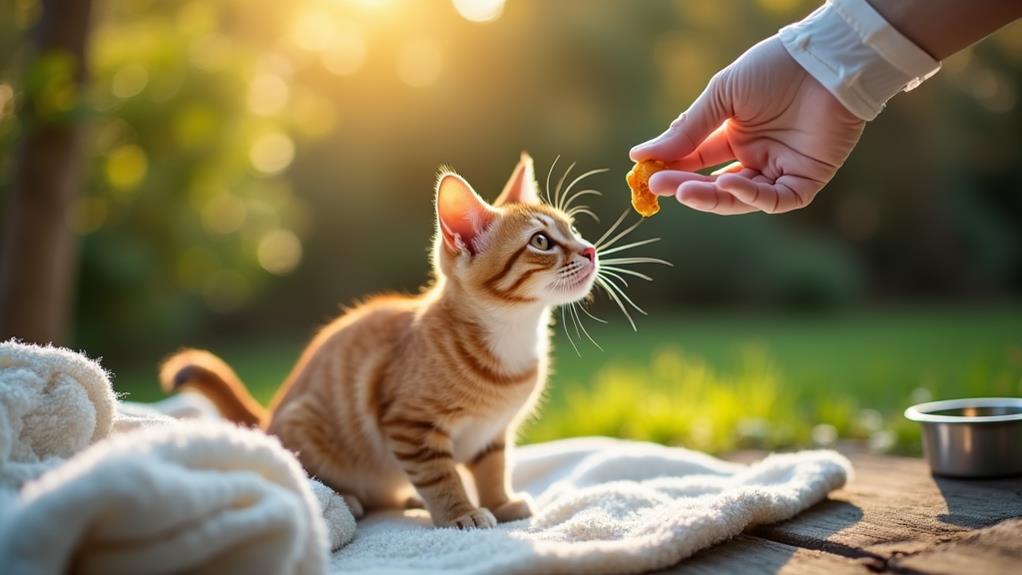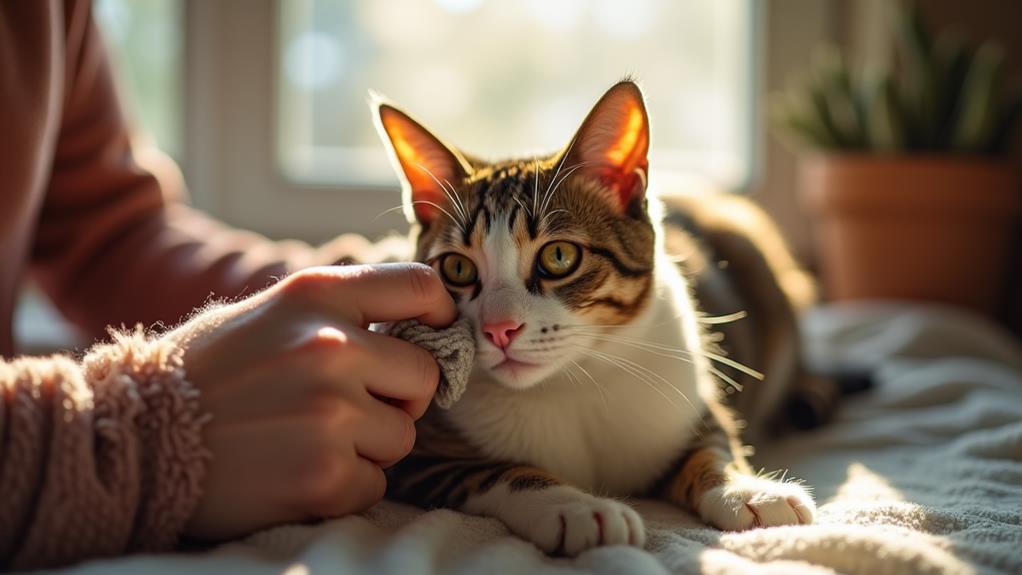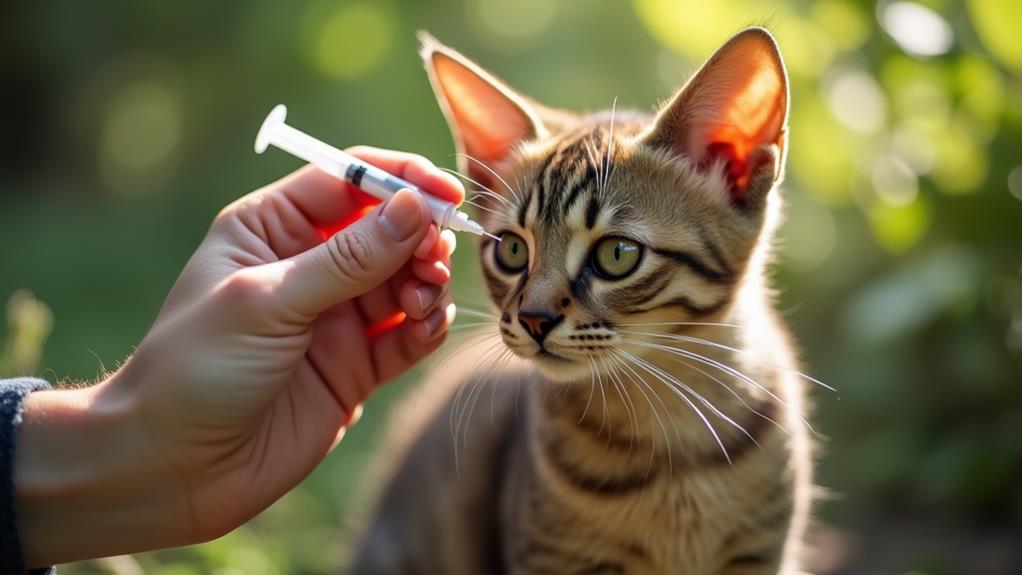How to Help a Feral Cat With an Eye Infection: A Step-by-Step Guide
Helping a feral cat with an eye infection requires patience and care. Start by observing symptoms like discharge, redness, or swelling. Approach the cat slowly and calmly, building trust with quiet presence and food. Use cooled boiled water and clean gauze to gently clean the eyes, and apply a safe eye wash if possible. Make certain the cat's environment is quiet and stress-free with access to fresh water and food. If symptoms persist or worsen, consult a vet for proper medication. By following these steps, you'll be well-prepared to support the cat's recovery and won't miss vital details ahead.
Recognizing Eye Infection Symptoms
Eye infections in feral cats can present several noticeable symptoms that you shouldn't ignore. When observing these cats, look for signs of eye discharge, which often appears as watery or gooey secretions. This discharge can indicate an infection that requires attention. Another symptom to watch for is excessive tear production, which could suggest that the cat's eyes are irritated or inflamed.
Redness of the eye is another common indicator of infection. It often accompanies other symptoms like squinting, which cats do to minimize discomfort or shield their eyes from further irritation. Squinting can be a sign that the cat is experiencing significant pain or sensitivity to light. Furthermore, you might notice swelling around the eye area. This swelling signifies inflammation and suggests that the infection might be progressing, possibly necessitating veterinary care.
Monitoring the cat's general behavior is also important. If the cat seems lethargic or has changes in eating habits, these could be indirect signs of a severe eye infection. Recognizing these symptoms early on can make a significant difference in helping the feral cat regain its health.
Safely Approaching Feral Cats
After recognizing the symptoms of an eye infection, approaching a feral cat safely becomes your next step. Feral cats are naturally wary of humans, so it's crucial to move slowly and quietly. Start by observing their behavior from a distance. This allows you to gauge their comfort level and guarantees you don't inadvertently cause stress or provoke a defensive reaction.
When you're ready to get a bit closer, use a calm voice to speak softly. Avoid direct eye contact, as feral cats might see this as a threat, making them more anxious. Instead, glance at them occasionally while keeping your posture relaxed.
To build trust, consider feeding the cat. Place some food a safe distance away and step back. Feeding creates a positive association, showing the cat that you're not a threat. With patience, they might start feeling safer around you.
Gradually introduce yourself by sitting quietly nearby. Allow the cat to approach you on its own terms. This slow approach fosters trust and gives you the best chance of helping them with their eye infection. Remember, patience and observation are key to successfully approaching feral cats.
Initial Assessment Techniques

In evaluating a feral cat's eye infection, start by ensuring you're in a well-lit environment for a clear view of the cat's eyes. This lighting helps you identify any redness, discharge, or squinting that might suggest an issue. Begin your initial assessment by gently and calmly approaching the cat, ideally using a trap to safely contain it. This minimizes stress and allows you to get closer without causing alarm.
Observe both eyes, comparing them for symmetry and noting any abnormalities. Look for signs like swelling, excessive tearing, or visible discomfort in one or both eyes. Pay attention to the discharge color; yellow or green could point to a bacterial infection, while clear discharge might indicate allergies or irritants. Document your observations carefully, noting any behavioral signs of discomfort and how long the symptoms have persisted. This detailed record will be invaluable for veterinary assessment and any professional advice you might seek later.
Essential Cleaning Supplies
When helping a feral cat with an eye infection, you'll need some important supplies to guarantee safe and effective care. Start by gathering cooled boiled water and a clean cotton ball or sterile gauze pads. These will help you gently wipe away any discharge from the cat's eyes, which is necessary to prevent further irritation or spreading the infection. Using a clean cotton ball each time makes sure that you don't introduce new bacteria.
Next, have Vetericyn Plus Antimicrobial Eye Wash on hand. This non-toxic formula is specifically designed for pets, allowing you to safely flush the affected eyes without needing to rinse afterward. It's effective and safe, giving you peace of mind during the cleaning process.
Don't forget to wear disposable gloves while handling the cat. This step is important to maintain hygiene and reduce the risk of transferring bacteria to or from the cat.
To guarantee the cat's comfort, prepare a quiet and secure space. Stock up on treats or food to entice the feral cat closer, making it easier to administer care. A comfortable environment will help minimize stress and encourage cooperation during cleaning.
Home Care for Eye Infections

Dealing with a feral cat's eye infection at home requires careful attention and a gentle touch. Begin by maintaining a clean environment, as this helps reduce irritants and allergens that could worsen the infection. Carefully clean the affected eye using a dampened cotton ball with cooled boiled water. This will help you wipe away any discharge. Remember to use separate cotton pieces for each eye to prevent cross-contamination.
After cleaning, apply a warm compress to the infected eye. This should soothe irritation and encourage healing. Hold it gently against the eye for a few minutes, repeating the process several times a day. The warmth will help alleviate discomfort and promote better circulation, aiding in recovery.
If the feral cat allows, consider using a cat-safe ophthalmic solution to flush the eye. This can help clean the area and relieve irritation. Be sure to do this procedure carefully to avoid causing any distress to the cat.
Keep a close eye on the symptoms. It's essential that you monitor any changes in the discharge or the cat's comfort level. These steps should effectively aid in managing a feral cat's eye infection at home.
When to Seek Veterinary Help
While home care can be quite effective for managing a feral cat's eye infection, certain situations demand professional intervention. If you notice the cat's symptoms, like excessive discharge, redness, or squinting, persist beyond 24 hours, it's time to seek veterinary help. These signs may indicate a more serious issue that requires a vet's expertise. Furthermore, if the cat's condition worsens, particularly with severe swelling, pain, or if the eye appears cloudy or has ruptured, consulting a veterinarian becomes vital.
An eye infection accompanied by symptoms such as nasal discharge, coughing, or lethargy might suggest an upper respiratory infection, necessitating urgent veterinary assistance. These symptoms indicate the infection could be affecting more than just the eye, posing a risk to the cat's general health.
Should the cat be unable to open its eye due to crusting or swelling, a vet should assess the situation swiftly to prevent further complications. For feral cats with a documented history of chronic eye issues or signs of systemic illness, seeking veterinary assistance is important. Underlying conditions may require specialized treatment to guarantee the cat's condition doesn't deteriorate further.
Administering Medications Safely

Administering medications safely to a feral cat requires careful planning and a gentle approach to ascertain both the cat's wellbeing and your safety. Initially, always consult a veterinarian before administering any medications. They'll ascertain the correct treatment and dosage tailored to the feral cat's specific condition. Regarding the application of antibiotic ointments, gently secure the cat by wrapping it in a towel. This calming technique reduces stress and prevents injury. Place a small amount of the ointment on your fingertip, then gently rub it along the cat's lower eyelid to apply it effectively.
For oral medications, mix the prescribed dosage with a small portion of wet food. This method encourages the cat to ingest it more easily without direct handling, which can be stressful for both you and the cat. After administering medications, closely monitor the cat for any adverse reactions or worsening symptoms. This vigilance is essential, as immediate follow-up with the veterinarian might be necessary if complications arise. Remember, the goal is to help the cat heal while maintaining a safe and stress-free environment for both of you. Keep communication open with the veterinarian for any adjustments or advice needed.
Creating a Recovery Environment
To create an ideal recovery environment for a feral cat with an eye infection, make sure the space is quiet, warm, and sheltered. A calm environment minimizes stress, allowing the cat to focus on recovery. Confirm the area is free from strong odors, dust, and other pets to avoid further irritation. It's vital to provide easy access to fresh water and high-quality food, supporting the cat's general health during this vulnerable time.
Maintain proper hygiene by using clean bedding and changing it regularly. This reduces the risk of further irritation or infection, promoting a healthier recovery process. Monitor the recovery area daily, making sure it stays clean and free from potential irritants. Observing the cat's progress is important; watch for any signs of improvement or worsening symptoms. If you notice any concerning changes, don't hesitate to seek veterinary assistance.
Preventative Measures for Future

After ensuring a supportive recovery environment, focusing on preventative measures can help reduce the recurrence of eye infections in feral cats. Start by regularly cleaning the cats' eyes with safe products like Vetericyn Plus Antimicrobial Eye Wash. This helps remove irritants and debris, essential in preventing infections. Establishing a clean environment is important, as it minimizes exposure to allergens and irritants that could trigger eye issues.
Additionally, consider vaccinating the feral cats against common diseases. Vaccinations can greatly reduce the risk of viral infections that lead to secondary eye problems. Implementing spay and neuter programs also plays a significant role. By controlling the population, you reduce the spread of infectious diseases, including those affecting the eyes.
Furthermore, monitor the health of feral cats through community feeding initiatives. Regular checks allow you to catch early signs of eye infections, enabling prompt treatment before they worsen. By taking these proactive steps, you're not only helping individual cats but also contributing to the general health of the feral cat community. With these preventative measures, you can make a meaningful difference in preventing future eye infections in feral cats.
Utilizing Community Resources
Harness the power of community resources to effectively support feral cats with eye infections. Local animal shelters are your initial stop. They often provide access to veterinary care and vital supplies specifically for feral cats facing health issues like eye infections. Don't overlook nonprofit organizations running trap-neuter-return (TNR) programs. These programs not only help manage feral cat populations but also provide necessary healthcare, including treatments for eye infections.
Many veterinary clinics understand the financial constraints of caring for feral cats and offer discounted services. This makes it more affordable to seek professional help for a feral cat in need. Remember, early intervention can prevent more severe health issues down the road.
Community outreach programs are invaluable. They offer educational resources and support, helping you understand how to effectively address and manage health concerns in feral cats. Networking with local rescue groups is also beneficial. They can connect you with financial aid or resources for veterinary treatment, ensuring the feral cats receive the necessary medical attention.




